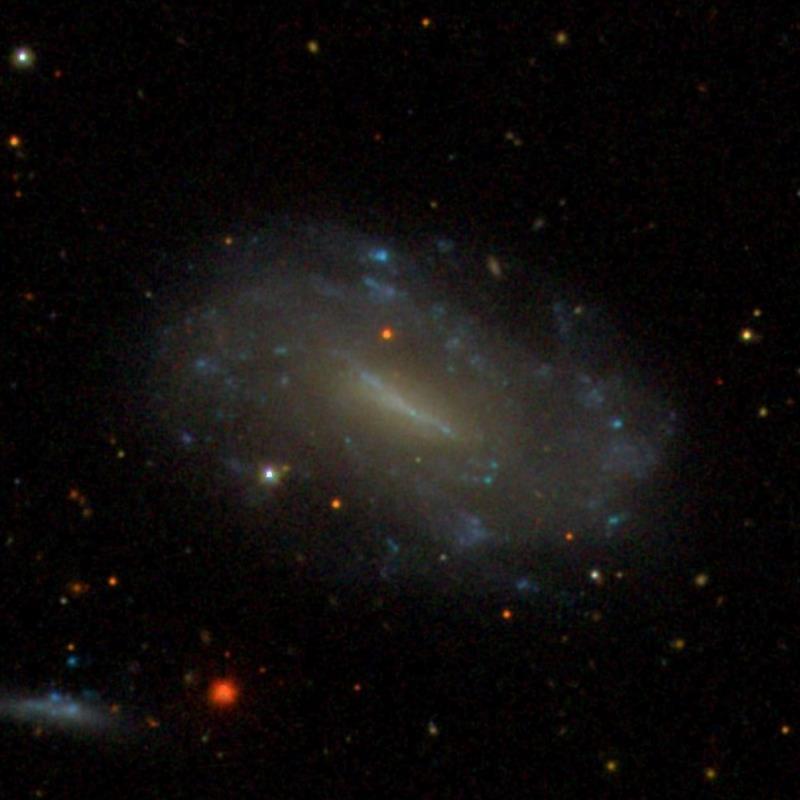|
NGC 5713
NGC 5713 is a peculiar, asymmetric galaxy in the constellation Virgo. Although classified as a spiral galaxy by most galaxy catalogs, NGC 5713 is very different from most normal spiral galaxies. While most spiral galaxies either have either two well-defined spiral arms or a filamentary spiral-like structure, this spiral galaxy has only one visible spiral arm in its disk. This makes it a galaxy of the Magellanic type. Gravitational interactions with the nearby spiral galaxy NGC 5719 may be responsible for producing the disturbed, asymmetric structure including the single spiral arm. NGC 5713 is at the center of a small group of spiral galaxies that also includes NGC 5691, NGC 5705, and NGC 5719. It is a member of the NGC 5746 Group of galaxies, itself one of the Virgo III Groups strung out to the east of the Virgo Supercluster of galaxies. Star formation Compared to many other nearby spiral galaxies, NGC 5713 appears to be a site of relatively intense star formation a ... [...More Info...] [...Related Items...] OR: [Wikipedia] [Google] [Baidu] |
New General Catalogue
The ''New General Catalogue of Nebulae and Clusters of Stars'' (abbreviated NGC) is an astronomical catalogue of deep-sky objects compiled by John Louis Emil Dreyer in 1888. The NGC contains 7,840 objects, including galaxies, star clusters and emission nebulae. Dreyer published two supplements to the NGC in 1895 and 1908, known as the ''Index Catalogues'' (abbreviated IC), describing a further 5,386 astronomical objects. Thousands of these objects are best known by their NGC or IC numbers, which remain in widespread use. The NGC expanded and consolidated the cataloguing work of William and Caroline Herschel, and John Herschel's ''General Catalogue of Nebulae and Clusters of Stars''. Objects south of the celestial equator are catalogued somewhat less thoroughly, but many were included based on observation by John Herschel or James Dunlop. The NGC contained multiple errors, but attempts to eliminate them were made by the ''Revised New General Catalogue'' (RNGC) by Jack W. Sulent ... [...More Info...] [...Related Items...] OR: [Wikipedia] [Google] [Baidu] |
NGC 5705
NGC 5705 is a spiral galaxy in the constellation Virgo. NGC 5705 is part of a small group of spiral galaxies that also includes NGC 5691, NGC 5713, and NGC 5719. It is a member of the NGC 5746 Group of galaxies, itself one of the Virgo III Groups strung out to the east of the Virgo Supercluster The Virgo Supercluster (Virgo SC) or the Local Supercluster (LSC or LS) is a mass concentration of galaxies containing the Virgo Cluster and Local Group, which itself contains the Milky Way and Andromeda galaxies, as well as others. At least ... of galaxies. References External links * Barred spiral galaxies 5705 52395 09447 Virgo (constellation) {{Spiral-galaxy-stub ... [...More Info...] [...Related Items...] OR: [Wikipedia] [Google] [Baidu] |
UGC Objects
UGC may refer to: Science and technology * Universal gravitational constant G, in physics * Uppsala General Catalogue, an astronomical catalogue of galaxies * UGC, a codon for cysteine * Unique games conjecture In computational complexity theory, the unique games conjecture (often referred to as UGC) is a conjecture made by Subhash Khot in 2002. The conjecture postulates that the problem of determining the approximate ''value'' of a certain type of gam ..., a conjecture in computational complexity Organisations * UGC (cinema operator), a European cinema chain, formerly Union Générale Cinématographique * UGC Fox Distribution, a former French-American film production company formed in 1995 * Union Graduate College, Schenectady, New York * United Grain Company, a Russian grain trading company based in Moscow * University Grants Commission (other) * University Grants Committee (other) * UnitedGlobalCom, former name of the cable TV operator Liberty Global * Un ... [...More Info...] [...Related Items...] OR: [Wikipedia] [Google] [Baidu] |
NGC Objects
The ''New General Catalogue of Nebulae and Clusters of Stars'' (abbreviated NGC) is an astronomical catalogue of deep-sky objects compiled by John Louis Emil Dreyer in 1888. The NGC contains 7,840 objects, including galaxies, star clusters and emission nebulae. Dreyer published two supplements to the NGC in 1895 and 1908, known as the ''Index Catalogues'' (abbreviated IC), describing a further 5,386 astronomical objects. Thousands of these objects are best known by their NGC or IC numbers, which remain in widespread use. The NGC expanded and consolidated the cataloguing work of William and Caroline Herschel, and John Herschel's ''General Catalogue of Nebulae and Clusters of Stars''. Objects south of the celestial equator are catalogued somewhat less thoroughly, but many were included based on observation by John Herschel or James Dunlop. The NGC contained multiple errors, but attempts to eliminate them were made by the ''Revised New General Catalogue'' (RNGC) by Jack W. Sulenti ... [...More Info...] [...Related Items...] OR: [Wikipedia] [Google] [Baidu] |
Peculiar Galaxies
A peculiar galaxy is a galaxy of unusual size, shape, or composition. Between five and ten percent of known galaxies are categorized as peculiar. Astronomers have identified two types of peculiar galaxies: ''interacting galaxies'' and ''active galactic nuclei'' (AGN). When two galaxies come close to each other, their mutual gravitational forces can cause them to acquire highly irregular shapes. The terms 'peculiar galaxy' and 'interacting galaxy' have now become synonymous because the majority of peculiar galaxies attribute their forms to such gravitational forces. Formation Scientists hypothesize that many peculiar galaxies are formed by the collision of two or more galaxies. As such, peculiar galaxies tend to host more active galactic nuclei than normal galaxies, indicating that they contain supermassive black holes. Many peculiar galaxies experience starbursts, or episodes of rapid star formation, due to the galaxies merging. The periods of elevated star formation and the l ... [...More Info...] [...Related Items...] OR: [Wikipedia] [Google] [Baidu] |



